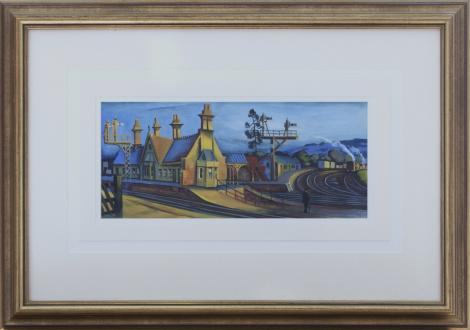Ashchurch Station

Ashchurch Station
Watercolour: Signed and dated 1960
Image: 5.5ins x 12ins - Framed: 15ins x 21ins
Suggested offer: £1,750
A most unusual painting from Norman's repertoire with vivid colours showing another side of this exceptional artist. Many of Norman's paintings are a valuable history and Ashchurch was an important junction linking Redditch Station to the south. Unfortunately the tunnel that ran under parts of the old town was deemed to be unsafe and when closed, so did the south link to Redditch. The north link from Redditch to Barnt Green and Birmingham still remains.
The original Ashchurch station was a stop on the Birmingham and Gloucester Railway, authorised in 1836, and whose central section from Bromsgrove to Cheltenham, including Ashchurch, was opened on 24 June 1840 (the line was open throughout a few months later). It subsequently became part of the Midland Railway, later the London, Midland and Scottish Railway during the Grouping of 1923, and finally passed to the London Midland Region of British Railways on nationalisation in 1948. It was then closed by the British Railways Board.
Ashchurch was once a railway centre of some importance, as it was the junction for two branches, one each side of the main line:
1. The Evesham line, actually a lengthy loop serving Evesham, Alcester and Redditch, re-joining the main line at Barnt Green, near Bromsgrove. This line closed between Evesham and Redditch on 15 October 1962 due to poor condition of the track, while Ashchurch to Evesham followed on 17 June 1963 (Redditch to Barnt Green remains open on the electrified Birmingham suburban network).
2. The line to Tewkesbury, Upton-upon-Severn and Malvern, closed beyond Upton on 1 December 1952, Ashchurch to Upton following on 14 August 1961. At this time Ashchurch station was renamed Ashchurch for Tewkesbury, but it too closed, on 15 November 1971, having been unstaffed since 14 September 1970. The buildings were demolished in June 1972, and the main line platforms and footbridge were removed early in 1974. There used to be a connecting curve linking the two branches, crossing the main line on the level just north of the station, creating a layout which may have been unique in Britain, but this curve closed in December 1957. There was an extensive goods yard to the south, and to the northwest a large grain store.
The remains of the old lines are still apparent, with much of its infrastructure (such as bridges) still in existence. The old connecting curve and the two branches it served can clearly be traced on a map.
